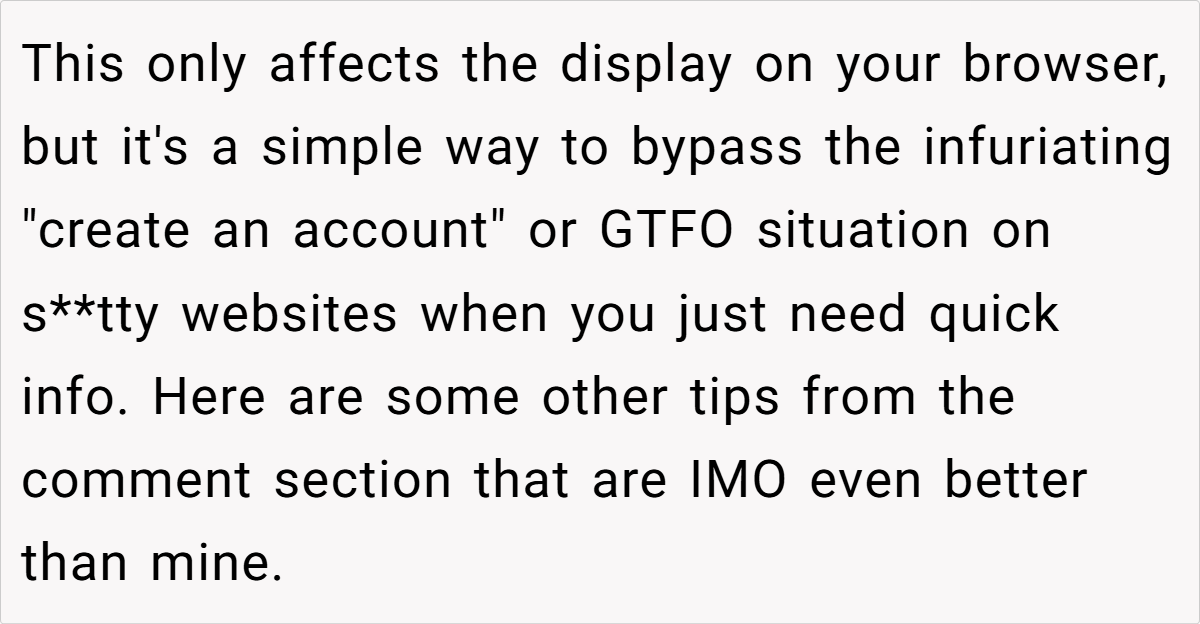Beat the System: How to Skip Annoying ‘Create an Account’ Walls Instantly
Have you ever found yourself trapped behind a website’s annoying “create an account” wall when all you need is a quick answer? It’s a digital dilemma that leaves many frustrated and scrambling for workarounds. In a world where convenience is king, this clever trick offers a refreshing escape from endless registration prompts, making it feel like you’ve just discovered a secret passage in your favorite old video game.
Imagine a scenario where, instead of surrendering to the website’s demands, you take control with a few keystrokes. This hack not only saves time but also injects a bit of rebellious fun into your online routine, inviting us all to question the status quo of digital gatekeeping.

‘LPT : If you are asked to create an account in order to continue browsing a website, hit F12 and click on the dim area, this would select it and you can delete it with DEL key, hit F12 again and resume your browsing.’





A quick glance at this hack reveals the ingenuity behind reclaiming our browsing freedom. As Steve Krug famously advised, “Don’t make me think!”—a reminder that user interfaces should be simple and intuitive. This tip ingeniously employs developer tools to erase obstructive elements, turning frustration into empowerment for everyday users.
Analyzing the OP’s situation, it’s clear that many websites deploy these account-creation prompts to gather data or boost engagement metrics. The hack, which involves using F12 to inspect and delete the intrusive overlay, highlights a fundamental disconnect between web design and user needs. It’s almost as if these sites are challenging us to outsmart their own digital barricades—an ironic twist in the age of user-centric design.
Broadening the discussion, forced registrations are symptomatic of a larger issue in today’s digital landscape. According to a Nielsen Norman Group study, a significant percentage of users abandon a website when confronted with tedious sign-up processes . This statistic underscores the importance of prioritizing seamless usability over aggressive data collection. In many ways, these tactics are counterproductive, alienating potential users rather than engaging them.
For example, actor Ryan Reynolds once humorously highlighted the absurdity of these digital barriers in a tweet that quickly went viral. His lighthearted jab, covered by Business Insider, resonated with millions of internet users. Reynolds’s take underscores that even celebrities are not immune to the frustrations of invasive online practices. His commentary serves as a potent reminder that usability should never be sacrificed for forced engagement.
To navigate such obstacles, experts advise both users and website owners to rethink their approach. While using developer tools to delete overlays is an effective short-term fix, it also points to a need for a broader change in design philosophy.
As Steve Krug’s iconic words remind us, “Don’t make me think!” Simplicity and intuitive navigation should be paramount. Websites might consider less intrusive methods to engage users, such as optional registrations or gradual data collection techniques, ensuring that convenience and functionality go hand in hand.
Here’s what people had to say to OP:
Here are some hot takes from the Reddit community—candid and humorous. Many redditors applauded the clever workaround, while others warned that the hack might not work on every site. The diverse opinions, marked in the original comment block below, capture the blend of admiration, skepticism, and witty banter that only a passionate online community can deliver:










In conclusion, this clever bypass not only offers a practical solution for immediate browsing woes but also invites us to question the increasingly invasive practices of modern websites. What are your thoughts on using such hacks to reclaim your digital space? Have you ever taken a similar stand against unnecessary online barriers? Share your experiences and join the discussion—let’s talk about how we can encourage a more user-friendly web.

